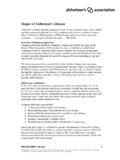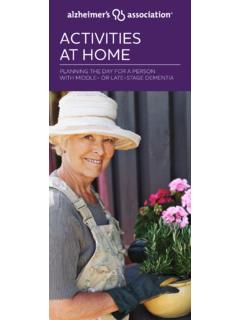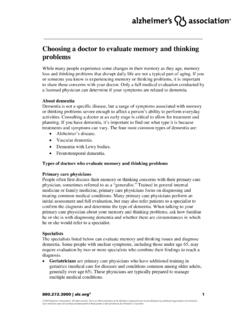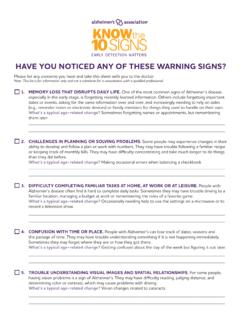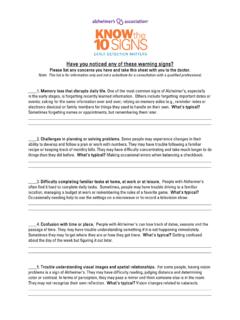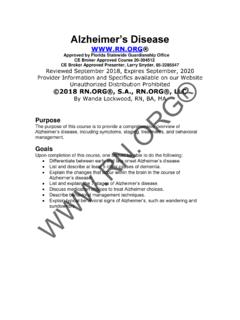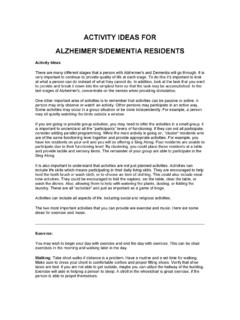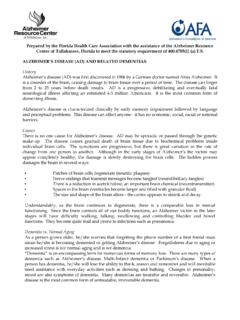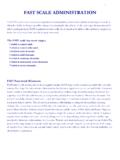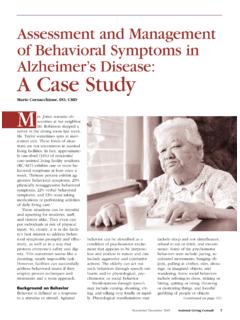Transcription of ACTIVITIES AT HOME - Alzheimer's Disease and …
1 ACTIVITIES AT HOMEPLANNING THE DAY FOR A PERSON WITH MIDDLE- OR LATE-STAGE DEMENTIA1 ACTIVITIES AND DEMENTIAA ctivities are the things we do. They can be active or passive, done alone or with person with dementia will eventually need assistance to plan daily ACTIVITIES . As the Disease progresses, these ACTIVITIES can enhance the person s sense of dignity and self-esteem by giving more purpose and meaning to his or her also structure time. They can make the best of a person s abilities and facilitate relaxation. Being active can also provide a sense of engagement, usefulness and accomplishment, which can help reduce behavior like wandering or agitation. Both a person with dementia and his or her caregiver can enjoy the sense of security and togetherness that ACTIVITIES ACTIVITIES Bring meaning, purpose, joy and hope.
2 Use the person s skills and abilities. Are enjoyable. Involve family and friends. Are dignified and appropriate for adults. Give the person a sense of normalcy. Focus on the process, not the Types of ACTIVITIES .. Planning ACTIVITIES .. Creating a daily plan .. Measuring the plan s success .. TYPES OF ACTIVITIESD aily routines may include: Chores: Dusting, sweeping, doing laundry. Mealtime: Preparing food, cooking, eating. Personal care: Bathing, shaving, ACTIVITIES may include: Creative: Painting, playing the piano. Intellectual: Reading a book, doing puzzles. Physical: Taking a walk, playing catch. Social: Having coffee, talking, playing cards. Spiritual: Praying, singing a hymn. Spontaneous: Visiting friends, going out to dinner.
3 Work-related: Making notes, fixing PLANNING ACTIVITIESFOCUS ON THE PERSONC onsider the person s likes and dislikes, strengths and abilities, and interests. As the Disease progresses, be ready to make adjustments. Keep the person s skills and abilities in mindStick with ACTIVITIES the person has always enjoyed. Adjust, as needed, to match the person s current attention to what the person enjoysTake note when the person seems happy, anxious, distracted or irritable. Some people enjoy watching sports, while others may be frightened by the fast pace or whether the person begins ACTIVITIES without directionDoes he or she set the table before dinner or sweep the kitchen floor mid-morning? If so, consider incorporating these ACTIVITIES into the daily aware of physical difficultiesConsider if the person tires quickly, or has difficulty seeing, hearing or performing simple movements.
4 Avoid challenging THE RIGHT ACTIVITYF ocus on enjoyment, not achievementChoose ACTIVITIES that build on current skills. A professional artist might become frustrated over a declining quality of work, but an amateur might enjoy new opportunities for involvement in daily lifeTasks like setting the table, wiping countertops and emptying wastebaskets can provide a sense of accomplishment and help the person feel like an active and valued member of the activity to work lifeA former office worker might enjoy ACTIVITIES that involve organizing, like putting coins in a holder, helping to assemble a mailing or making a to-do list. A former farmer or gardener may take pleasure in working in the for favoritesA person who always enjoyed reading the newspaper may still enjoy this activity, even if he or she can no longer completely understand the ACTIVITIES as neededTry to be flexible and acknowledge the person s changing interests and time of dayCaregivers may find they have more success with certain ACTIVITIES at specific times of day, such as bathing and dressing in the morning.
5 Make modifications to your daily routine as ACTIVITIES to Disease stagesAs the Disease progresses, you may want to introduce more repetitive tasks. Be prepared for the person to eventually be less YOUR APPROACHO ffer support and supervisionYou may need to demonstrate the activity and provide step-by-step on the process, not the resultTry to focus on what matters: spending time together and helping the person feel flexibleIf the person insists that he or she doesn t want to do something, it may be because of inability or fear. If the person insists on doing something a different way, let them and correct any mistakes later, if realistic and relaxedDon t be concerned about filling every minute with an activity. The person with dementia needs a balance of activity and rest, and may need frequent get the activity startedMany people living with the Disease still have the energy and desire to do things but lack the ability to organize, initiate and complete ACTIVITIES into simple, easy-to-follow stepsFocus on one step at a time.
6 Too many directions at once can be with difficult parts of the taskIf you re cooking and the person can t measure the ingredients, finish the measuring and encourage a different task, such as the individual know he or she is neededAsk: Will you please help me? Be careful, however, not to place too many demands on the the connectionIf you ask the person to make a card, he or she may not respond. But if you say that you re sending a special get-well card to a friend and invite him or her to join you, the person may enjoy the t criticize or correctEven if the person enjoys a harmless activity that seems insignificant or meaningless, encourage him or her to self-expressionInclude ACTIVITIES that allow the person a chance for expression, such as painting, drawing or listening to the person through conversationWhile you re polishing shoes, washing the car or cooking dinner, talk about what you re doing.
7 Even if the person cannot respond, he or she can benefit from the an activity for a behaviorIf a person with dementia rubs his or her hand on a table, provide a cloth and encourage the person to wipe the table. Or, if the person is moving his or her feet on the floor, play music so he or she can tap to the again laterIf the activity isn t working, it may be the wrong time of day or that the activity is too complicated. Try again later or adapt THE ENVIRONMENTMake ACTIVITIES safeRemove hazardous materials and tools from a workshop so an activity like sanding a piece of wood can be enjoyable and your surroundingsPlace scrapbooks, photo albums or old magazines in easily accessible spots to encourage the person to distractionsA person with dementia may feel uncomfortable in certain settings even if in a familiar place or surrounded by familiar sounds.
8 Minimizing distractions can help the person feel at TIPS FOR ACTIVITIES AT home 1. Be flexible and patient. 2. Encourage involvement in daily life. 3. Avoid correcting the person. 4. Help the person remain as independent as possible. 5. Offer opportunities to make choices. 6. Simplify instructions. 7. Establish a familiar routine. 8. Respond to the person s feelings. 9. Simplify, structure and Provide encouragement and CR E ATI N G A DAILY PLANWhen planning the day for a person with dementia , consider that there are days when he or she may want variety and others when routine is best. Try to find enjoyable ACTIVITIES that provide meaning and keeping a daily journal to note: Which ACTIVITIES worked best and why? Which didn t work?
9 Were there times with too much going on or too little to do? Were spontaneous ACTIVITIES enjoyable or did they create anxiety and confusion?Use your learnings to set up a daily plan so you can spend less time and energy figuring out what to do. Allow flexibility for spontaneous ACTIVITIES and MEASURING THE PLAN S SUCCESSTo determine if the daily plan is working, consider the person s response to each activity. The success of an activity can vary from day to day. In general, if the person seems bored, distracted or irritable, it may be time to introduce another activity or take a and pleasant ACTIVITIES often can reduce agitation and improve mood. The type of activity and how well it s completed is not as important as the joy and sense of accomplishment the person gets from doing DAILY PLANM orning Wash, brush teeth, get dressed.
10 Prepare and eat breakfast. Have a conversation over coffee. Discuss the newspaper, try a craft project, reminisce about old photos. Take a break, have some quiet time. Do some chores. Take a walk or play an active Prepare and eat lunch, read mail, wash dishes. Listen to music, do crossword puzzles, watch T V. Do some gardening, take a walk, visit a friend. Take a short break or Prepare and eat dinner, clean the kitchen. Reminisce over coffee and dessert. Play cards, watch a movie, give a massage. Take a bath, get ready for bed, read a alzheimer s Association is the leading voluntary health organization in alzheimer s care, support and research. Our mission is to eliminate alzheimer s Disease through the advancement of research; to provide and enhance care and support for all affected; and to reduce the risk of dementia through the promotion of brain health.
